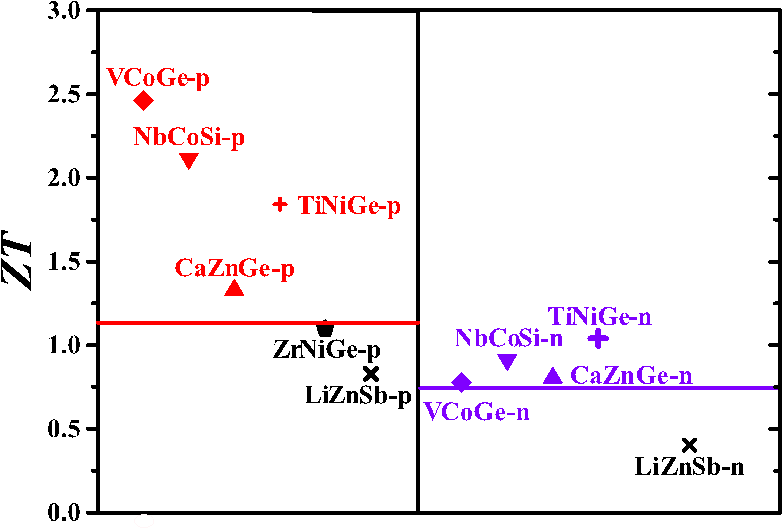Recently, Chinese researchers filtered out nine p-type and six n-type promising half-Heusler thermoelectric materials through high-throughput computations and revealed the underlying physical nature of high thermoelectric performance.
Thermoelectric materials (TE) have long been an attractive route in pursuing sustainable energy generation by recovering the waste heat to electric power. The thermoelectric performance is characterized by the dimensionless figure of merit, ZT, and in order to achieve a high ZT value, a synergistic combination is desired: large S for enhanced voltage output, high σ for depression of heat loss, and low κ for maintenance of the temperature gradient.
Among all of the state-of-the-art TE materials, the half-Heusler compounds are promising candidates for high-temperature applications, which is attributed to the excellent power factors, mechanical robustness, thermal stability, tunable properties, and reasonable cost.
Except for the experimentally and theoretically studied HH thermoelectrics (such as NbFeSb, ZrNiSn, ZrCoBi, and TiCoSb), the thermoelectric properties (electrical properties plus thermal properties) of many HH compounds have not been investigated yet.
Therefore, finding pristine HH compounds with promising thermoelectric properties (the high power factor or intrinsically low thermal conductivity) would open up a new way for high-performance thermoelectric materials.
Professor ZHANG Yongsheng’s group at Institute of Solid State Physics, Hefei Institutes of Physical Science studied the electronic structures of 95 HHs and selected 47 materials within a proper band gap in the region of [0.3 eV, 0.9 eV]. Using the effective mass and deformation potential theory to evaluate the electrical properties (the electronic relaxation time and power factor) of these 47 HH compounds and set the power factors of NbFeSb and ZrNiSn as the threshold, they screened out nine p-type and six n-type promising HH candidates.
Based on the electronic structure calculations, they found that not only the high band degeneracy but also the low deformation potential, light band, and high phonon velocity contribute to their large power factors.
For those filtered out compounds (with high power factors and environmentally friendly and low-cost elements), they carried out (quasi) harmonic phonon calculations to study the thermal properties using the first-principles Debye-allaway approach.
Two compounds (LiZnSb and CaZnGe) possessed low lattice thermal conductivities at 300 K (1.79 and 3.43 m-1 K-1 for LiZnSb and CaZnGe), which was ascribed to the weak interatomic interaction and high lattice anharmonic vibrations. The rest of the HH compounds possessed similar lattice thermal conductivity to that of NbFeSb at high temperature (900 K). Even with the lowest thermal conductivity, LiZnSb was not a promising thermoelectric material due to the unexcited band structures and poor power factors. Combining excellent electrical properties and relatively low thermal conductivity, VCoGe, NbCoSi, and TiNiGe were the promising HH thermoelectric materials with high ZT.
The research was supported by the financials of National Natural Science Foundation of China and the Major/Innovative Program of Development Foundation of Hefei Center for Physical Science and Technology Grant. The calculations were performed in the Center for Computational Science of CASHIPS, the ScGrid of Supercomputing Center and Computer Network Information Center of Chinese Academy of Sciences, and AM-HPC.
Link to the paper: Electrical Property Dominated Promising Half-Heusler Thermoelectrics through High-Throughput Material Computations

Schematic flow chart of the high-throughput electrical calculations in HH compounds to screen better p-type (n-type) pristine HH compounds with better electrical properties than NbFeSb (ZrNiSn). (Image by GUO Shuping)

Theoretically estimated ZT values of the predicted HH compounds at 900 K. The red and purple lines represent the theoretically calculated ZT values of NbFeSb and ZrNiSn, respectively. (Image by GUO Shuping)
Contact:
ZHOU Shu
Hefei Institutes of Physical Science (http://english.hf.cas.cn/)
Email: zhous@hfcas.ac.cn
 Tel: +86-551-65591206
Tel: +86-551-65591206
 Fax: +86-551-65591270
Fax: +86-551-65591270
 Emai: zhous@hfcas.ac.cn
Emai: zhous@hfcas.ac.cn
 350 Shushanhu Road
350 Shushanhu Road